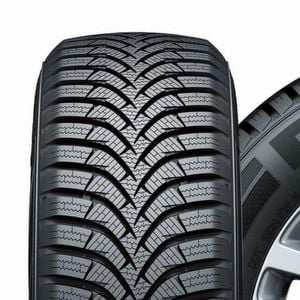Last Updated on 18.12.2024 by hrushetskyy

Regular tire rotation and balance are two absolutely necessary maintenance tasks that impact your vehicle’s tires’ performance, safety, and longevity. Tire rotation helps all four tires wear evenly, maximizing tread life and improving traction and handling. Thanks to tire balancing, all tires can support an equal amount of weight, preventing uneven wear and increasing overall driving comfort. Our mechanic explains the intricacies of tire rotation and balancing and answers all important questions at the end of this post.
Tire rotation
Why is it important to rotate your tires?
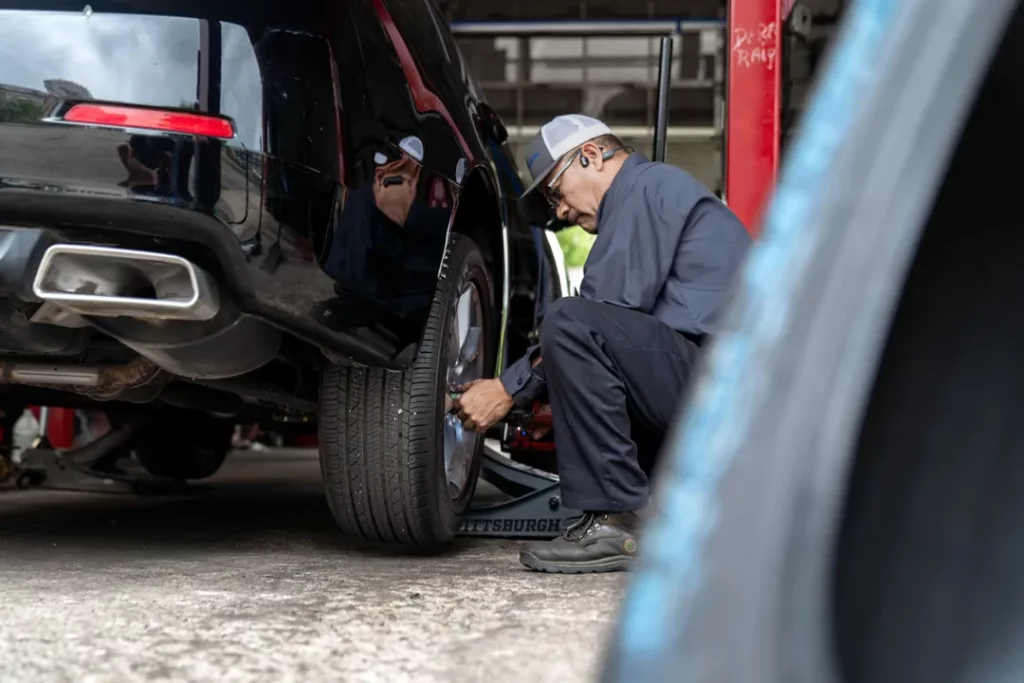
Tire rotation is part of your vehicle’s basic maintenance. Regular rotation will extend the life of your tires for up to 30% of total mileage, improve their performance, and increase your vehicle’s overall safety. Without rotating, you will experience poor performance and unnecessarily spend money on repairs or new tires.
As you drive, your tires get worn differently; the front two tires will wear down much faster than the rear tires. The front wheels do most of the braking and power transfer, causing them to wear easily. Also, the car’s engine is heavy and located in the front of the car, which adds more weight for the front tires to support. The wear of your tires will also differ depending on your driving habits and the terrain. In addition to constant steering, turning, and breaking, all these factors contribute to the wear of your tires.
During tire rotation, the front left tire is moved to the rear axle on the same side of the vehicle. The rear left tire is also repositioned to the front left position as part of a front-to-back tire movement strategy.
Through regular rotation, you will equalize the wear of your tires and maximize the traction of each wheel. The wear of each tire will be even, enabling you to get more miles out of them before buying a new set of tires.
The most important “consequence” of tire rotation is the increased safety of your drive. With rotated tires, you can handle your car better and make sudden turns or stops more effectively. You will also be able to get more miles out of each tire before it needs to be replaced, saving you significant cash. Plus, you will have a much smoother ride, increased traction, and improved gas mileage.
Benefits of regular tire rotation

Regular tire rotation offers numerous benefits, including:
- Even tread wear: Tire rotation helps all four tires wear evenly, maximizing tread life and improving traction and handling.
- Improved fuel efficiency: Properly rotated tires can improve fuel efficiency, as uneven wear can increase rolling resistance.
- Enhanced safety: Regular tire rotation can help prevent uneven wear—a danger of reduced traction and increased risk of accidents.
- Extended tire life: By distributing wear evenly across all four tires, regular rotation can extend the life of your tires.
- Better handling and performance: Properly rotated tires can improve handling and performance, especially during cornering and braking.
How often should you rotate your tires?
It is generally recommended that tires should be rotated every six months or for every 5,000 to 7,000 miles. An easy way to remember is to ask to have your tires rotated after every other oil change. During tire rotations, rear axle tires are often moved to the front for even wear.
As with any type of maintenance, manufacturers have different recommendations based on the make and model of the car. If you have the manual and specifications that came with your car, always consult them when possible. However, if you can’t find these specifications, there are general rules you can follow.
Signs it’s time to rotate your tires
While the recommended tire rotation interval varies depending on the vehicle manufacturer and driving conditions, several signs indicate it’s time to rotate your tires:
- Uneven tread wear: Check your tires for uneven wear patterns, such as feathering or cupping
- Vibration while driving: If your vehicle vibrates, it may indicate uneven tire wear or imbalance
- Reduced fuel efficiency: If you notice a decrease in fuel efficiency, it could be due to uneven tire wear
- Tire noise: Unusual tire noise, such as humming or whining, can indicate uneven wear or imbalance.
Tire rotation patterns
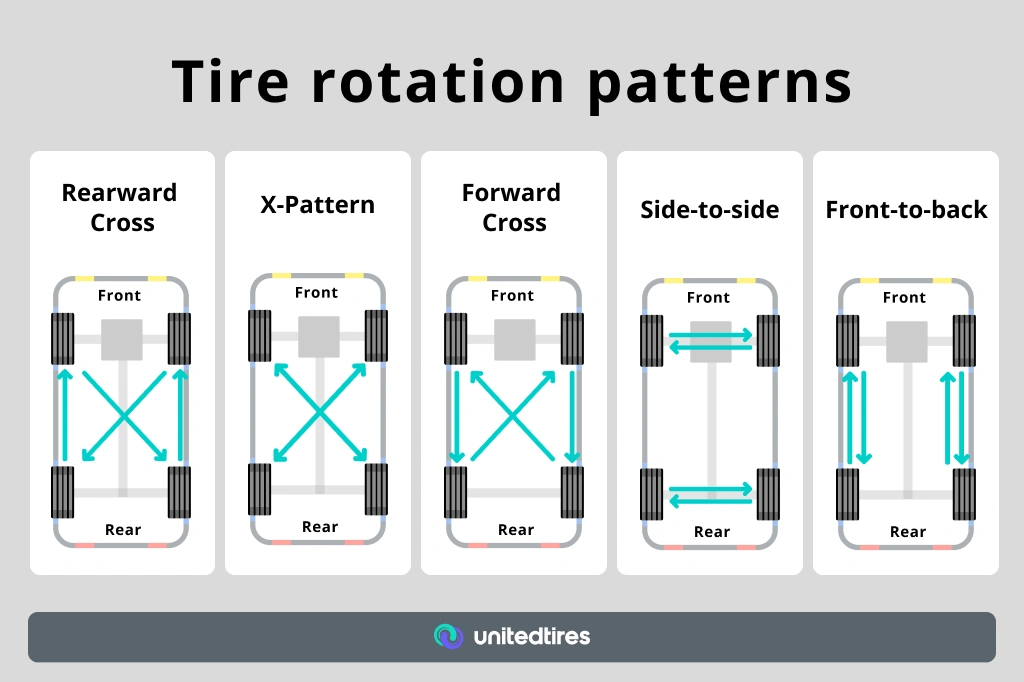
There are several tire rotation patterns, including:
- Rearward cross: This method is used for rear-wheel drive vehicles. It involves moving the rear tires to the front axle while keeping them on the same side.
- X-Pattern: This method is used for 4-wheel and all-wheel drive vehicles. It requires moving all tires diagonally, from one axle to the opposite and from one side to the other.
- Forward cross: This method is recommended for front-wheel drive vehicles. It involves moving the front axle tires directly to the back and the rear tires up diagonally to the opposite side of the front axle.
- Side-to-side: This method is best for vehicles with differently-sized performance tires on the front and rear axles. It involves switching tires with their same-sized partner while remaining on the same axle.
- Front-to-back: This method is recommended for directional tires. It involves moving all tires from one axle to the other while keeping them on the same side of the vehicle.
Vehicle-specific considerations for tire rotation
When it comes to tire rotation, it’s essential to consider the specific needs of your vehicle:
- Rear-wheel drive vehicles typically require a rearward cross-pattern
- Front-wheel drive vehicles typically require a forward cross-pattern
- 4-wheel and all-wheel drive vehicles typically require an X-pattern
- Directional tires require a front-to-back pattern
- Spare tire: If your vehicle has a full-size spare tire, you must include it in the rotation pattern, too!
How do I know when my tires need to be rotated?
As tires age, they develop wear problems, making rotating them unavoidable if you want to maintain their health. Ideally, you would want to have your tires rotated before noticeable wear appears on them.
Although it is important to rotate your tires regularly before visible signs, there are certain things to look out for. Signs of uneven wear are a clear indicator that you need to rotate your tires, even if only one tire shows excessive wear. You can also have professional maintenance and inspection performed on your vehicle at least once a year to check the wear of your tires, among other things.
How to rotate your car tires: DIY tips

We recommend always taking your car to a professional shop for any kind of regular maintenance; however, if you have professional experience, you can also do it in your own garage.
Remember to always check the specifications and manufacturer’s guidelines. This is an important step, as different manufacturers will have different recommendations based on the car’s make and model.
Check with a tire service professional to look for any misalignment or imbalance before rotation (tire imbalance will be covered later in this post). During the rotation, each tire and wheel are removed from the vehicle and moved to a different position on the car to make sure that all tires wear evenly and last longer. You want to rotate the tires from front to back and back to front or diagonally (see the image below for a helpful visual when determining where to move the tires).
If your tires are specific to one side of the car, you will want to rotate them from the front to the back, not from side to side. Always refer to the manual for your vehicle when possible, especially if confused. If you drive a car with tires that are two different sizes, where the front and rear tires are different sizes, you will need to rotate the tires from side to side rather than from front to back. Also, if you have a cheap temporary spare, you should consider whether you want to incorporate it into your rotation.
Tools for tire rotation
- Lug nut wrench
- Torque wrench
- Car jack
- Jack stands
- Tire crayon (optional)
- Temporary spare tire (if you decide to add it into the rotation)
A lug nut wrench is a useful tool and should be owned by anyone who owns a car. It’s super easy to use and store in the trunk. And it costs under $20.
A torque wrench prevents accidentally overtightening or damaging the wheels. The recommended specifications for torque wrenches can be found in your owner’s manual and on a very useful website, www.wheel-size.com. A good-quality torque wrench can be bought for under $30 and is easily stored.
A car jack provides strength and support while getting a vehicle off the ground. It goes under the thin lip of your car, close to the tires. Your car manual will explain the safest place to place it. Most importantly, you need to know that car jacks should not be used to hold a vehicle in place, this is what jack stands are for. A basic car jack costs around $20.
NOTE: A car jack must be rated at a capacity higher than your vehicle’s!
Jack stands prevent the car from falling and prevent injuries. This tool is an absolute must! The process will be very dangerous if you don’t use jack stands!
NOTE: Jack stands must be rated at a higher capacity than your vehicle’s.
A sturdy pair of jack stands is sold for under $40.
If you’ve never used a car jack or jack stand or want to brush up on the basics, watch the video below.
A tire crayon helps to mark the tires. It is optional, but it can make the process easier and prevent accidentally mixing the tires up while you rotate them. It costs just a few bucks.
As for the spare tire, carefully consider if you want to use it in your rotation.
NOTE: Before rotating your tires, make sure your car is parked on firm, level ground. Hilly, soft surfaces are unsafe for tire rotation!
12 steps of tire rotation

1. Put your car in “park” or “gear” if you have a manual transmission
2. Set the parking brake firmly and turn off the engine
3. As a precaution, place blocks ahead of the tires to prevent the car from moving
4. Loosen the lug nuts using the lug nut wrench, but do not completely remove them
5. Use the jack to raise the car and place it on the jack stands for stability
6. Completely loosen the lug nuts
7. Remove the tires and mark them with the tire crayon for easy identification if you decide to use tire crayons
8. Rotate your tires according to the pattern you wish to follow, such as moving the tires from front to back or diagonally
9. Screw the lug nuts back in with the lug nut wrench, but do not tightly screw them in yet
10. Slowly lower the car to the ground with the car jack
11. Tighten the lug nuts completely with a torque wrench
12. Repeat this process until all of your tires have been rotated
You have just successfully rotated your tires. Remember to rotate them regularly, preferably in a tire shop with high-end equipment!
Tire balancing
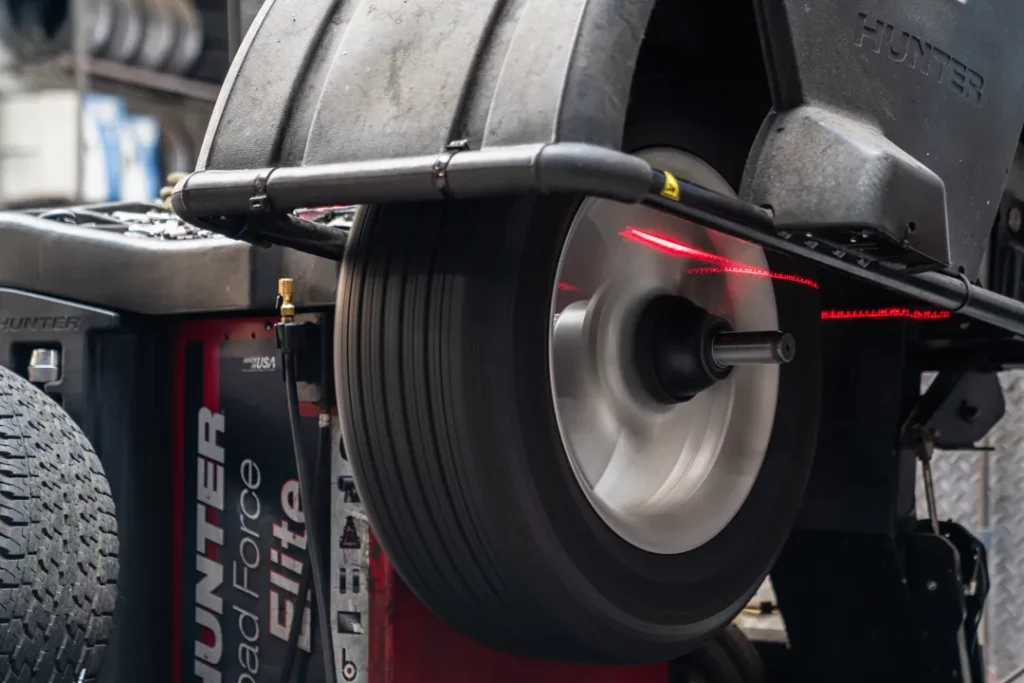
Why is it important to balance your tires?
In addition to rotating your tires, you should balance your tires regularly. Tire balancing is the process of ensuring that all of your tires are supporting an equal amount of weight. If a particular tire supports a disproportionate amount of weight compared to the others, it will wear more. At high speeds, the slightest imbalance in weight can cause the wheel to spin irregularly, damaging the tires. Balancing your tires will prevent this damage and increase their performance and lifespan. Furthermore, your tires will spin smoothly at high speeds and wear evenly.
New tires absolutely must be balanced right after being mounted! Keep in mind that balancing doesn’t correct issues that come with physically warped and irregular tires. Most mechanical garages, car dealerships, and forward tire ships have professional tire balancing equipment and we highly recommend taking your car to a mechanic rather than performing these serious tasks at home!
Different types of imbalance
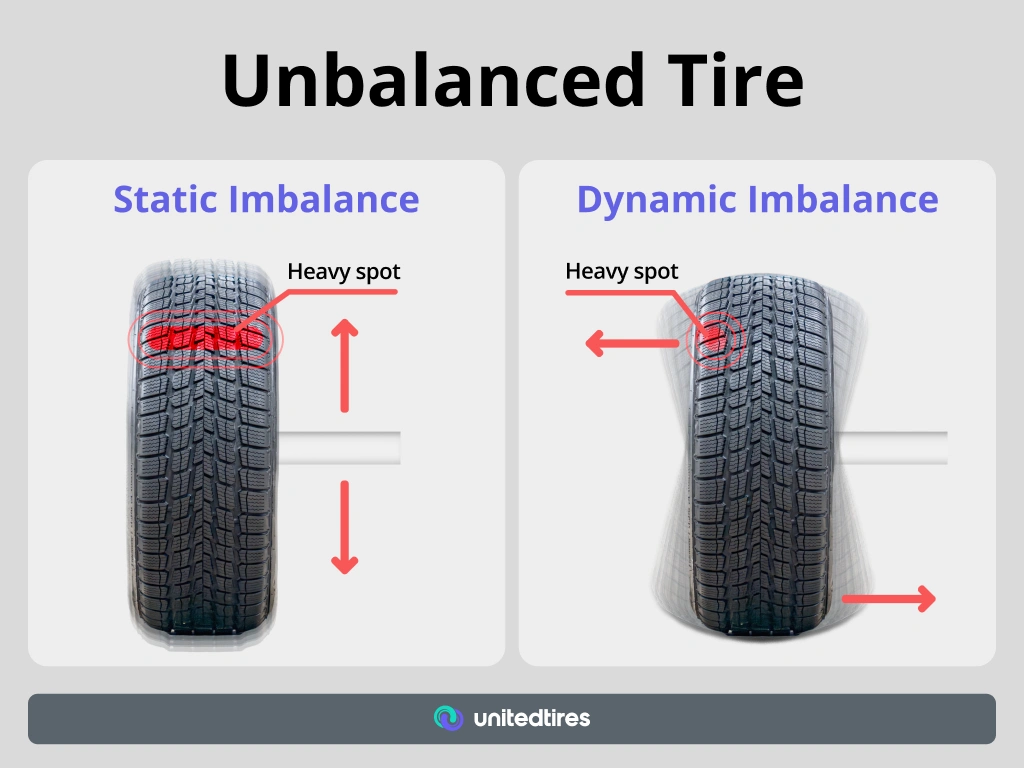
Two types of tire imbalance can occur: static and dynamic.
Static imbalance occurs when a heavy or light section in the tire prevents the tire from rotating evenly. This causes an up-and-down motion or hop.
The following image demonstrates a static imbalance:
Dynamic imbalance occurs when an unequal amount of weight is on either one or both sides of the wheel’s lateral centerline. This creates a side-to-side motion or wobble.
How often should you balance your tires?
Similarly, with tire rotation, balancing your tires should be a part of your car’s regular maintenance. When to balance tires can vary among manufacturer recommendations, but it is generally recommended to balance them every 5,000-7,000 miles, or with every other tire rotation.
Tire imbalance is a greater problem for SUVs and four-wheel-drive trucks, especially if frequently driven off-road. In these cases, the tires must be rebalanced more often, and always remember to balance new tires too!
How do I know when my tires need to be balanced?

As with tire rotation, you want to have your tires balanced regularly before any noticeable warning signs appear.
If you haven’t had your tires regularly balanced, check for any steering wheel vibration. You can also have professional maintenance and inspection performed on your vehicle at least once a year, which will check the wear of your tires, among other things.
Frequently Asked Questions
How often should I get my tires rotated?
You must rotate your tires every 5,000 to 7,500 miles. However, always refer to your vehicle’s owner’s manual for the manufacturer’s specific guidelines.
Why is tire rotation important?
Tire rotation helps tires wear evenly, extending their lifespan to about 30% in the mileage, improving gas economy, and contributing to a smoother, safer ride.
When should I get my tires balanced?
You should get your tires balanced whenever you experience vibrations, uneven tire wear, or after purchasing new tires. Having them checked every 5,000 to 7,500 miles is also a good idea, often in conjunction with tire rotations.
What are the signs that my tires need to be balanced?
Signs that your tires need balancing include vibrations in the steering wheel, seat, or floorboard and uneven tire wear.
Can I rotate and balance my tires myself?
We don’t recommend doing so. While it’s possible to rotate and balance your tires if you have the proper tools and knowledge, it’s often best to leave these tasks to professionals. They have specialized equipment and knowledge, the guarantee that the job is done correctly and safely.
Share the Knowledge
